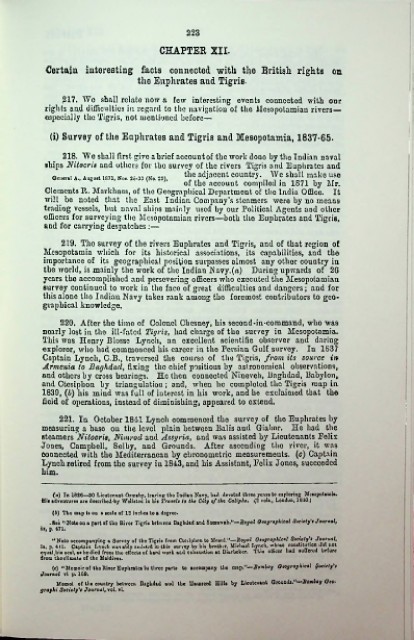Page 249 - Gulf Precis (VI)_Neat
P. 249
223
CHAPTER XII.
Certaiu interesting facts connected with the British rights on
the Euphrates and Tigris-
217. Wo shall rclalo now a few interesting events connected with onr
rights aud difficulties in regard to the navigation of the Mesopotamian rivers—
especially the Tigris, not mentioned before—
(i) Survey of the Euphrates and Tigris and Mesopotamia, 1837-65.
218. Wo shall first give a brief account of the work done by the Indian naval
ships Nilocris and others for the survey of the rivers Tigris and Euphrates and
the adjacent country. We shall make use
General A., August 1871, Nee. 25*33 (No. 29).
of the account compilod in 1871 by Mr.
Clements R. Markham, of the Geographical Department of the India Office. It
will he noted that the East Indian Company’s steamers were by no means
trading vessels, but naval ships mainly used by our Political Agents and other
officers for surveying the -Mesopotamian rivers—both the Euphrates and Tigris,
and for carrying despatches :—
219. Tlio survey of the rivers Euphrates and Tigris, and of that region of
Mesopotamia which for its historical associations, its capabilities, and the
importance of its geographical position surpasses almost any other country in
the world, is mainly the work of the Indian Navy.(a) During upwards of 2G
years the accomplished and persevering officers who executed the Mesopotamian
survey continued to ivork in the face of great difficulties and dangers; and for
this alone the Indian Navy takes rank among the foremost contributors to geo
graphical knowledge.
220. After the time of Colonel Chesney, his second-in-command, who was
noarly lost in the ill-fatod Tigris, had charge of the survey in Mesopotamia.
This was Henry Blosse Lynch, an excellent scientific observer and daring
explorer, who had commenced his career in the Persian Gulf survey. In 1837
Captain Lynch, C.B., traversed the course of the Tigris, from its source in
Armenia to Baghdad, fixing the chief positious by astronomical observations,
and others by cross hearings. He then connected Nineveh, Baghdad, Babylon,
and Ctesiphon by triangulatiou; and, when lie completed the Tigris map in
1839, (6) his mind was full of iutercst in his work, and he exclaimed that the
field of operations, instead of diminishing, appeared to extend.
221. Ia October 1811 Lynch commenced the survey of tlio Euphrates by
measuring a base on the level plain between Balis aud Giabor. He had the
steamers Nitocris, Nimrod aud Assyria, and was assisted by Lieutenants Felix
Jones, Campbell, Selby, and Grounds. After ascending tho river, it was
connected with the Mediterranean by chronometric measurements. (c) Captain
Lynch retired from the survey in 1813, and his Assistant, Felix Jones, succeeded
him.
(а) In 1826—30 Lieutenant Ormsby, leaving tlio Indian Navy, had dovotod three yean to exploring Mesopotamia.
His adventurea nro doscribodby Woilitcd in his Travel! to the City of the Caliphi. (2 vola., London, 1810.)
(б) Tho map ii on a scale of 12 indict to a degree.
-8oo "Notcou a part of tho Kivor Tigris betxvecu Baghdad and Samawah."—3oyal Geographical Society'! Journal,
ix, p. 471.
"Note accompanying a Survey of tho Tigris from Ctcdphon to Mosul.”—lioyal Geographical Society t Journo/,
ix, p. 411. Captain Lynch was ably audited iu this survey by his brother, Michael Lynch, whoso constitution did not
cqual'bis zeal, as lie died from tho effects of hard work and exhaustion at Diurbckcr. Tl.is ofliccr had suffered before
from thoclimalu of the Maldives.
(c) “Memoir of tho Hirer Euphrates lu three parts to accompany tho map.’’—Horn Joy Geographical $ociety*t
Journal vi p. 1G9.
Moinoi of tho country botweeu Baghdad aud the Uiinrccd Hills by Lieutenant Grounds."—Bombay Geo•
graphi Society1! Journal, yoh vl.

